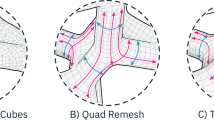Abstract
The current computer-aided technologies in design and product development, the evolution of CAD modeling, and a framework of multi-volume CAD modeling system for heterogeneous object design and fabrication are presented in this paper. The multi-volume CAD modeling system is presented based on nonmanifold topological elements. Material identifications are defined as design attributes introduced along with geometric and topological information at the design stage. Extended Euler operation and reasoning Boolean operations for merging and extraction are executed according to the associated material identifications in the developed multi-volume modeling system for heterogeneous object. An application example and a pseudo-processing algorithm for prototyping of heterogeneous structure through solid free-form fabrication are also described.
Similar content being viewed by others
References
Sun W, Lau A. Design for manufacturability and concurrent engineering in integrated product development process. InProceeding of Concurrent Product Design and Environmentally Conscious Manufacturing, Billatos S B, Zhang H C (eds.), 1997 the ASME Winter Annual Meeting, Nov.16–21, 1997, Dailas, TX, pp. 113–124.
Sun W, Lau A. DFMA in rapid product development. InProceedings of the International Forum on Product Design for Manufacture and Assembly, June 9–10, 1997, Newport, RI, pp. 152–161.
Jo H H, Parsaei H R, Sullivan W G. Principle of Concurrent Engineering.Concurrent Engineering — Contemporary Issues and Modern Design Tools, Parsaei H R, Sullivan W G (eds.), Chapman & Hall Publishing, 1993, pp.3–23.
Kruth J P. New Manufacturing Techniques for Rapid Prototyping and Concurrent Engineering. Manufacturing in the Era of Concurrent Engineering, Halevi G, Weill R (eds.), North-Holland Publishing, 1992, pp.51–82.
Bedworth D D, Henderson M R, Wolfe P M. Computer-Integrated Design and Manufacturing. McGraw-Hill, Inc., 1991.
Sun W, Lau A, Ko F. Integrated design for manufacturing of composite automotive components. InProceedings of the Fourth International Conference of Composite Engineering, July 6–12, 1997, Big Island, Hawaii, pp.561–562.
Sun W, Ko F. Computer-aided design and simulation for 3D fabric composite armor. InProceedings of the 5th International Conference on Composites Engineering, Las Vegas, July 5–9, 1998, pp.863–864.
Weiss L. Solid freefrom fabrication process. NSF Workshop on Design Methodologies for Solid Freeform Fabrication, June 5–6, 1995, EDRC, Carnegie-Mellon, Pittsburgh, PA, NSF 96–216.
Duan W, Zhou J, Lai K. FSMT: A feature solid-modelling tool for feature-based design and manufacturing.Computer-Aided Design, 1993, 25(1): 29–38.
Martino T D, Falcidieno B, Giannini F, Hassinger S, and Ovtcharova J. Feature-based modelling by integrating design and recognition approaches.Computer-Aided Design, 1994, 26(8): 646–653.
Chamberlain M A, Joneja A, Chang T-C. Protrusion-features handling in design and manufacturing planning.Computer-Aided Design, 1993, 25(1): 19–28.
Henderson M R. Extraction of feature information from three-dimensional CAD data.Ph.D. Thesis, Purdue University, USA, 1984.
Masuda H. Topological operators and Boolean operations for complex-based non-manifold geometric models.Computer-Aided Design, 1993, 25(2): 119–129.
Laakko T, Mantyla M. Feature modeling by incremental feature recognitions.Computer-Aided Design, 1993, 25(1): 479–492.
Rossignac J R, Requicha A A G. Constructive non-regularized geometry.Computer-Aided Design, 1991, 23(1): 21–32.
Cavalcanti P R, Carvalho P C P, Martha L F. Non-manifold modeling: An approach based on spatial subdivision.Computer-Aided Design, 1997, 29(3): 209–220.
Sun W, Lau A. A Knowledge-enriched CAD modeling and solid free-form realization for heterogeneous material structures. InProceedings of the Seventh International Conference on Rapid Prototyping, March 31 — April 3 1997, San Francisco, CA, pp.79–87.
Kumar V, Dutta D. An approach to modeling heterogeneous objects. InProceedings of the Solid Freeform Fabrication Symposium 1997, Austin, TX, 1997.
Weiler K. The Radial Edge Structure: A Topological Representation for Non-Manifold Geometric Boundary Modeling. Wozny M J, McLaughlin H W. Encarnacao J L (eds.), Geometric Modeling for CAD Application, North-Holland Publishing, 1988, pp.3–36.
Author information
Authors and Affiliations
Corresponding author
Additional information
SUN Wei is Drexel’s first Pei Chi Chou Professorship Holder in the Department of Mechanical Engineering and Mechanics and Director of Rapid Product Development Center at Drexel. Dr. Sun received his Ph.D. degree in Mechanical Engineering in 1992. His current research interests are in the area of modern design and manufacturing, computer-aided technologies for rapid product development and product realization, modeling and simulation of heterogeneous composites and tissue engineering, concurrent engineering and rapid prototyping. He has extensive expertise and experience in using integrated CAD/CAE/CAM and advanced design and manufacturing tools for research, education, and engineering consultation. In his role as the Director of Rapid Product Development Center since 1994, Dr. Sun has assisted over 100 design and manufacturing companies in the Greater Philadelphia area with their technology advancement and product competitiveness. As a Professor in the Mechanical Engineering Department, Dr. Sun has developed and taught a number of CAD and CAD/CAM courses at the graduate and undergraduate level and has supervised Doctoral and Master degree graduate students. Dr. Sun has been invited to conduct many lectures, seminars, workshops and conference presentations in the United States, Hong Kong and China, and has published many technical papers and lecture books in the research area he is working on. Dr. Sun currently also serves as a Visiting Professor in Hefei University of Technology, Hefei, China, and a Visiting Professor in Gansu University of Technology, Lanzhou, China. He is currently a member of American Academy of Mechanics (AAM), American Society of Mechanical Engineering (ASME), American Society of Engineering Education (ASEE), Society of Manufacturing Engineering (SME), and Society of Rapid Prototyping.
Rights and permissions
About this article
Cite this article
Sun, W. Multi-volume CAD modeling for heterogeneous object design and fabrication. J. Comput. Sci. & Technol. 15, 27–36 (2000). https://doi.org/10.1007/BF02951924
Received:
Revised:
Issue Date:
DOI: https://doi.org/10.1007/BF02951924




